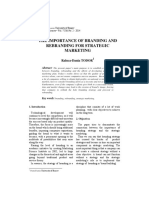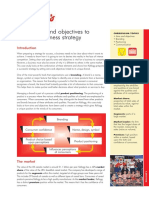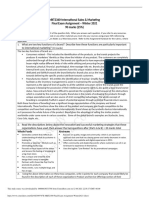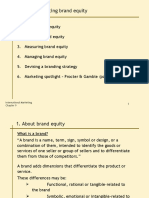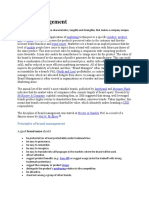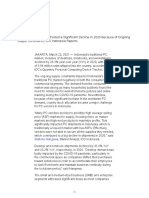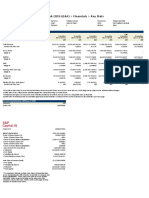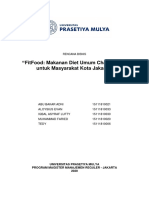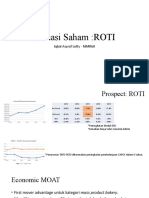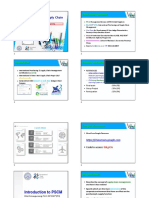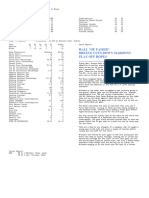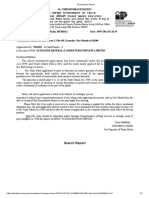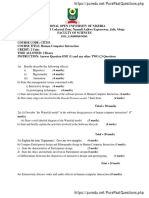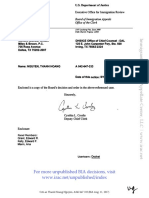Brand and Branding
Brand and Branding
Uploaded by
TEDY TEDYCopyright:
Available Formats
Brand and Branding
Brand and Branding
Uploaded by
TEDY TEDYOriginal Title
Copyright
Available Formats
Share this document
Did you find this document useful?
Is this content inappropriate?
Copyright:
Available Formats
Brand and Branding
Brand and Branding
Uploaded by
TEDY TEDYCopyright:
Available Formats
See discussions, stats, and author profiles for this publication at: https://www.researchgate.
net/publication/272184078
Brand and Branding
Chapter · January 2015
DOI: 10.1002/9781118785317.weom120161
CITATION READS
1 45,785
1 author:
Tanya Sammut-Bonnici
University of Malta
83 PUBLICATIONS 249 CITATIONS
SEE PROFILE
Some of the authors of this publication are also working on these related projects:
Wiley Encyclopedia of Management Vol 9 Marketing View project
Wiley Encyclopedia of Management - Vol 12 Strategic Management View project
All content following this page was uploaded by Tanya Sammut-Bonnici on 30 October 2017.
The user has requested enhancement of the downloaded file.
brand and branding developed by differentiating product attributes
such as product features, quality, selection,
Tanya Sammut-Bonnici price, and availability. Competitive brand posi-
tioning can be developed by addressing each
DEFINITION stage in the value chain from production to the
point of sale.
A brand can be defined as a set of tangible and Value chain development is based primarily on
intangible attributes designed to create aware- product innovation and market development
ness and identity, and to build the reputation of a (see Figure 1). Product innovation includes
product, service, person, place, or organization. strategic initiatives on product design and the
The holistic perspective of branding as a long- ability to introduce new product categories and
term strategy includes a wide set of activities line extensions. Market development revolves
ranging from product innovation to marketing around pricing strategy, distribution strategy,
communications. and marketing communications. Communi-
The objective of branding strategy is to create cations are designed to create a consumer
brands that are differentiated from the competi- mindset where brand awareness, associations,
tion, thereby reducing the number of substitutes and attitudes are formed. Brand names, logos,
in the marketplace. When high brand equity advertising, and product packaging constitute
is achieved through brand differentiation, the the visual component of market development.
price elasticity of demand becomes low, allowing Major competitors in the food manufacturing
the company to increase price and improve industry include Nestlé, PepsiCo, Unilever,
profitability. and Kraft. The corporations strive to improve
Branding strategies are built on the inter- their product offering giving particular atten-
dependent frameworks of competitive brand tion to the freshness of the product, health,
positioning, value chain development, and nutrition, and cost considerations. Over and
brand equity management. above, they have to differentiate their brands
Competitive brand positioning requires the within their own categories and within the wider
identification of a distinct market space and a market space. Nestlé owns 17 brand categories,
cognitive location as perceived by consumers. with 23 separate brands in the cereal category
Effective brand positioning helps strategists alone. Each brand is developed with a sepa-
determine what the brand stands for, its unique rate identity created through distinct product
selling points, how it overlaps with competing content, packaging, and product line extensions.
brands, and the value derived from the usage Pricing scales add to the distinction of high
of the brand. A competitive position is attained value and low value brands in the same cereal
through strong brand recognition, which can be category.
Product design
Pricing Distribution Marketing Competitive
and product line
strategy strategy communications brand position
innovation
Figure 1 Strategic brand development and the value chain.
Wiley Encyclopedia of Management, edited by Professor Sir Cary L Cooper.
Copyright © 2014 John Wiley & Sons, Ltd.
2 brand and branding
The concerted efforts of product development successful brands or by differentiating
and market development secure a competitive it sufficiently to attract new customers.
position for the brand, resulting in higher Hotel chains such as Marriot, Radisson,
revenues and the increase of shareholder value. and Westin engage in this type of strategy
Brand equity is the set of assets and liabilities across their advertising, product promo-
associated with a brand, such as the positive tions, and loyalty programs. Differentiation
image of Coca Cola in terms of a recreational of the brand from competing products
beverage, or its negative image in terms of health through visual imagery and marketing
and the consumption of sugar. Brand equity communications allows companies to posi-
management is becoming an important compo- tion their products in a crowded market
nent of corporate strategy. Strategists would space.
need to capitalize on the positive aspects of the • Brand protection. Much time and effort
brand and minimize liabilities through: would be dedicated to protecting the brand
through copyright and trademarks. Google
• Association and differentiation. Brand equity alone has 293 trademarks under its corporate
is built by associating the brand with other umbrella.
Rank Brand Brand value Consumer Brand Company Industry
($bil) perception revenue advertizing
rank ($bil) ($mil)
1
Apple 87.1 11 108.2 933 Technology
2
Microsoft Microsoft 54.7 1 73.7 1600 Technology
3
Coca-Cola 50.2 29 22.8 3256 Beverages
4
IBM 48.5 20 106.9 1373 Technology
5
Google 37.6 7 36.5 1544 Technology
6
Intel 32.3 6 54 2100 Technology
7
McDonald’s 37.4 85 85.9 769 Restaurants
8
General electric 33.7 49 124.7 - Diversified
9
BMW 26.3 5 73.7 - Automative
10
Cisco 26.3 15 46.1 325 Technology
CISCO
Figure 2 The world’s most powerful brands (Badenhausen, 2012).
brand and branding 3
RANKING OF GLOBAL BRANDS Bibliography
The measurement of brand equity is a combi-
nation of financial value and positive consumer Ataman, M.B., Van Heerde, H.J. and Mela, C.F. (2010)
The long-term effect of marketing strategy on brand
affinity. Some brands are financially valuable
sales. Journal of Marketing Research, 47 (5), 866–882.
in terms of revenue and profitability while
Badenhausen, K. (2012) World’s Most Powerful Brands.
others resonate with consumers. The top 100 Forbes, 2 (10), 100–115.
global brands rank the best at both metrics (see Dahlen, M., Lange, F. and Smith, T. (2010) Marketing
Figure 2). Communications: A Brand Narrative Approach, JWA,
NYSE.
FUTURE DIRECTIONS Erdem, T. and Swait, J. (2004) Brand credibility, brand
Strategies for long-term brand loyalty are devel- consideration and choice. Journal of consumer research,
oped around hybrid initiatives addressing brand 31 (1), 191–198.
image and brand experience. The trend in Fill, C. (2009) Marketing Communications: Interac-
tivity, Communities and Content, Prentice Hall,
branding strategy is to permeate brand identity
USA.
through all the functions of the firm that address
Keller, K.L. and Lehmann, D.R. (2006) Brands and
the customer and to expand on the brand expe- branding: research findings and future priorities.
rience. The focus of the brand experience is Marketing Science, 25 (6), 740–759.
moving beyond the customer’s perception of a Morgan, N.A. and Rego, L.L. (2009) Brand portfolio
brand, to the measureable metrics of customer strategy and firm performance. Journal of Marketing,
satisfaction throughout the value chain and 73 (1), 59–74.
customer retention. Schmitt, B., Zarantonello, L. and Brakus, J. (2009)
Brand experience: what is it? How is it measured?
Does it affect loyalty? Journal of Marketing, 73 (3),
See also GE matrix (competitive position attrac- 52–68.
tiveness matrix); life cycle strategy; portfolio Wheeler, A. (2009) Designing Brand Identity: An Essential
management; segmentation Guide for the Whole Branding Team, JWA, NYSE.
View publication stats
You might also like
- Window StickerDocument1 pageWindow Stickerjbdietz2021No ratings yet
- Strategic Brand Management Building Measuring and Managing Brand Equity 4th Edition Kevin Solutions ManualDocument11 pagesStrategic Brand Management Building Measuring and Managing Brand Equity 4th Edition Kevin Solutions ManualKeithRomeros100% (1)
- Draft 1 Seminar 2 FitFoodsDocument200 pagesDraft 1 Seminar 2 FitFoodsTEDY TEDYNo ratings yet
- Acme Risk PlanDocument22 pagesAcme Risk PlanCarlos GuachaminNo ratings yet
- 3 Brand ManagementDocument55 pages3 Brand ManagementAdam SchubertNo ratings yet
- Strategic Brand Management: Chapter NineDocument180 pagesStrategic Brand Management: Chapter NineSilfa nidi FahiraNo ratings yet
- Building Strong Brands (Review and Analysis of Aaker's Book)From EverandBuilding Strong Brands (Review and Analysis of Aaker's Book)No ratings yet
- End To End Recruitment ProcessDocument57 pagesEnd To End Recruitment ProcessMayuri Dalvi100% (4)
- Taguchi Quality Loss FunctionDocument18 pagesTaguchi Quality Loss FunctionMohammed ImranNo ratings yet
- Brand and BrandingDocument4 pagesBrand and BrandingAatam ShahNo ratings yet
- Brand and BrandingDocument4 pagesBrand and BrandingJorge Alberto CerdaNo ratings yet
- Brand and Branding: January 2015Document4 pagesBrand and Branding: January 2015Lia Boutiq MeiNo ratings yet
- Value Chain Development: Brand and BrandingDocument3 pagesValue Chain Development: Brand and BrandingBint OsmanNo ratings yet
- Chapter 1Document10 pagesChapter 1Ajouwad Khandoker ÆdibNo ratings yet
- Creating Brand EquityDocument9 pagesCreating Brand Equityzubdasyeda8No ratings yet
- Brands & Brand ManagementDocument15 pagesBrands & Brand ManagementliaqatNo ratings yet
- Creating Brand EquityDocument32 pagesCreating Brand Equityibekmamad2100% (2)
- Brands & Brand Management: Kevin Lane Keller Tuck School of Business Dartmouth CollegeDocument104 pagesBrands & Brand Management: Kevin Lane Keller Tuck School of Business Dartmouth CollegeCarl ReyNo ratings yet
- Brand Management Chapter 1 Kevin Lane KellerDocument18 pagesBrand Management Chapter 1 Kevin Lane KellerRiya ShahNo ratings yet
- Examining The Influence of Marketing Mix On Retailer Brand Awareness: A Focus On Detergent ProductsDocument6 pagesExamining The Influence of Marketing Mix On Retailer Brand Awareness: A Focus On Detergent ProductsInternational Journal of Innovative Science and Research TechnologyNo ratings yet
- Branding Strategies of AirtelDocument30 pagesBranding Strategies of AirtelAgon Tuk25% (4)
- S12. Brand Architecture StrategyDocument46 pagesS12. Brand Architecture StrategyBảo TrươngNo ratings yet
- The Importance of Branding and Rebranding For Strategic MarketingDocument6 pagesThe Importance of Branding and Rebranding For Strategic MarketingSarah KleinNo ratings yet
- Chapter 11Document10 pagesChapter 11Ajouwad Khandoker ÆdibNo ratings yet
- Strategic Application of Dual-Branding in Brand Building ProcessDocument4 pagesStrategic Application of Dual-Branding in Brand Building ProcesssarveshsonissNo ratings yet
- Chapter Nine Strategic Brand Management: Mcgraw-Hill/Irwin © 2006 The Mcgraw-Hill Companies, Inc., All Rights ReservedDocument19 pagesChapter Nine Strategic Brand Management: Mcgraw-Hill/Irwin © 2006 The Mcgraw-Hill Companies, Inc., All Rights Reservedravie2009No ratings yet
- BRM CH1 PDFDocument23 pagesBRM CH1 PDFShahzad QasimNo ratings yet
- SPRINT 1 Global Brand ManagementDocument22 pagesSPRINT 1 Global Brand ManagementPuja MukherjeeNo ratings yet
- 1428 SampleDocument6 pages1428 SampleAbid uddinNo ratings yet
- Kelloggs 12 FullDocument4 pagesKelloggs 12 Fullapi-3705095100% (2)
- Chapter 11 - GE - Fin - StudentsDocument43 pagesChapter 11 - GE - Fin - StudentsTasnova Lutfor 1825062090No ratings yet
- Brand Building & Brand ManagementDocument36 pagesBrand Building & Brand Managementmikhil.muraliNo ratings yet
- 170 407012 MarketingPlanTemplateHubSpot PDFDocument17 pages170 407012 MarketingPlanTemplateHubSpot PDFprabinaind69No ratings yet
- Wa0004Document6 pagesWa0004Muhammad UsamaNo ratings yet
- KL Kotler MM 14e 05 IpptDocument82 pagesKL Kotler MM 14e 05 IpptĐậu ToeicNo ratings yet
- ? TYBMS SEM VI Brand Management 2020 MDocument19 pages? TYBMS SEM VI Brand Management 2020 MHaydn Homan100% (1)
- 170 407012 MarketingPlanTemplateHubSpot PDFDocument17 pages170 407012 MarketingPlanTemplateHubSpot PDFprabinaind69No ratings yet
- Using Aims and Objectives To Create A Business Strategy - A Kellogg's Case Study PDFDocument4 pagesUsing Aims and Objectives To Create A Business Strategy - A Kellogg's Case Study PDFSeethalakshmy NagarajanNo ratings yet
- MarketingDocument10 pagesMarketingThe SpectreNo ratings yet
- Brand ManagementDocument4 pagesBrand ManagementShivaNo ratings yet
- C9 Strategic Brand - IUBDocument35 pagesC9 Strategic Brand - IUBMd. Muhinur Islam AdnanNo ratings yet
- Keller SBM3 01 1Document20 pagesKeller SBM3 01 1kajal malhotraNo ratings yet
- DM Coca Cola 3Document18 pagesDM Coca Cola 3Minh HoàngNo ratings yet
- Jjurnal klp1Document46 pagesJjurnal klp1Immawan WahyudiNo ratings yet
- Keller SBM4 IM 01Document12 pagesKeller SBM4 IM 01ahmad_sokarNo ratings yet
- 7E MKT2360 Final Exam Assignment Winter2021 1Document6 pages7E MKT2360 Final Exam Assignment Winter2021 1tamanna sharmaNo ratings yet
- Lec 9 Brand Architecture StrategiesDocument41 pagesLec 9 Brand Architecture StrategiesPrasanta Das100% (1)
- Chapter 4-Market-Focused Program DevelopmentDocument58 pagesChapter 4-Market-Focused Program DevelopmentAec Advertisng100% (1)
- Personalizing MarketingDocument9 pagesPersonalizing MarketingChiragNarulaNo ratings yet
- Chapter 9Document12 pagesChapter 9fatoumatta jaitehNo ratings yet
- Brochure Kellogg Strategies That Build Winning Brands 26-July-2022 V16Document15 pagesBrochure Kellogg Strategies That Build Winning Brands 26-July-2022 V16abhishekNo ratings yet
- BM Unit-6 Designing and Sustaining Brand StrategiesDocument22 pagesBM Unit-6 Designing and Sustaining Brand Strategiessanketh jainNo ratings yet
- BrandbuildingofRetailStores MSS - Deepaanddr.pchiramaniDocument17 pagesBrandbuildingofRetailStores MSS - Deepaanddr.pchiramaniswaaaaNo ratings yet
- Brand Leadership: Prepared by Zeina El HasanDocument11 pagesBrand Leadership: Prepared by Zeina El HasanZaina HassanNo ratings yet
- International University School of Business MBA Class 02 - Group 6Document57 pagesInternational University School of Business MBA Class 02 - Group 6Nhat PHanNo ratings yet
- Brand Management Is The Application ofDocument5 pagesBrand Management Is The Application ofdeepakNo ratings yet
- BrandsDocument12 pagesBrandsdostmuhammad18No ratings yet
- Brand Management Kelompok 3Document46 pagesBrand Management Kelompok 3ToniJ 31No ratings yet
- MrktingDocument11 pagesMrktinganindyaaus2007No ratings yet
- Lecture 52 WEEK 11Document30 pagesLecture 52 WEEK 11Arpita DeyNo ratings yet
- Session - 11,12 Brand EquityDocument54 pagesSession - 11,12 Brand EquityKush patidarNo ratings yet
- Brand-Leadership (Review and Analysis of Aaker and Joachimsthaler's Book)From EverandBrand-Leadership (Review and Analysis of Aaker and Joachimsthaler's Book)No ratings yet
- The Brandgym, third edition: A Practical Workout to Grow Your Brand in a Digital AgeFrom EverandThe Brandgym, third edition: A Practical Workout to Grow Your Brand in a Digital AgeNo ratings yet
- Marketing Planning by Design: Systematic Planning for Successful Marketing StrategyFrom EverandMarketing Planning by Design: Systematic Planning for Successful Marketing StrategyNo ratings yet
- Konsumsi Fast Food Dan Kuantitas Tidur Sebagai Faktor Risiko Obesitas Siswa SMA Institut Indonesia SemarangDocument8 pagesKonsumsi Fast Food Dan Kuantitas Tidur Sebagai Faktor Risiko Obesitas Siswa SMA Institut Indonesia SemarangTEDY TEDYNo ratings yet
- W07 PSCM Tools-RevDocument8 pagesW07 PSCM Tools-RevTEDY TEDYNo ratings yet
- Nama, Email, Dan UniversitasDocument2 pagesNama, Email, Dan UniversitasTEDY TEDYNo ratings yet
- Financial Statement UltimateDocument52 pagesFinancial Statement UltimateTEDY TEDYNo ratings yet
- IDC Indonesia's PC Market Posted A Significant Decline in 2020 Because of Ongoing Supply Constraints, IDC Indonesia Reports - 2021 MarDocument6 pagesIDC Indonesia's PC Market Posted A Significant Decline in 2020 Because of Ongoing Supply Constraints, IDC Indonesia Reports - 2021 MarTEDY TEDYNo ratings yet
- PT Garuda Indonesia Persero TBK IDX GIAA FinancialsDocument48 pagesPT Garuda Indonesia Persero TBK IDX GIAA FinancialsTEDY TEDYNo ratings yet
- PT Nippon Indosari Corpindo TBK IDX ROTI FinancialsDocument46 pagesPT Nippon Indosari Corpindo TBK IDX ROTI FinancialsTEDY TEDYNo ratings yet
- Business Plan - FitFoodDocument289 pagesBusiness Plan - FitFoodTEDY TEDYNo ratings yet
- Business Valuation - ROTIDocument21 pagesBusiness Valuation - ROTITEDY TEDYNo ratings yet
- Framework For Purchasing & Supply Strategy: Key QuestionsDocument4 pagesFramework For Purchasing & Supply Strategy: Key QuestionsTEDY TEDYNo ratings yet
- Behavioral Study of Consumers While Buying New Laptop or ComputerDocument19 pagesBehavioral Study of Consumers While Buying New Laptop or ComputerTEDY TEDYNo ratings yet
- Understanding Supply Markets: Key QuestionsDocument5 pagesUnderstanding Supply Markets: Key QuestionsTEDY TEDYNo ratings yet
- W06 Supplier Relationship and The Supplier Perception ModelDocument4 pagesW06 Supplier Relationship and The Supplier Perception ModelTEDY TEDYNo ratings yet
- W01 Introduction To PSCM-revDocument7 pagesW01 Introduction To PSCM-revTEDY TEDYNo ratings yet
- C Programming Success in A DayDocument105 pagesC Programming Success in A DayAnishReddy100% (1)
- 3-DOF Longitudinal Flight Simulation Modeling and Design Using MADocument54 pages3-DOF Longitudinal Flight Simulation Modeling and Design Using MAspbhavna100% (1)
- Maroons at BluesDocument3 pagesMaroons at BluesChris WrightNo ratings yet
- Automation and Robotics Course File After SEE 2023-24Document5 pagesAutomation and Robotics Course File After SEE 2023-24Aveen K PNo ratings yet
- Estwani ISO CodesDocument9 pagesEstwani ISO Codesनिपुण कुमारNo ratings yet
- STEM Gonzales Kerwwyn Gray Earthquake Drill Complete Paper FINAL EXAM in RESEARCH 2Document32 pagesSTEM Gonzales Kerwwyn Gray Earthquake Drill Complete Paper FINAL EXAM in RESEARCH 2gonzalesivanjamesNo ratings yet
- Project For Sustainable Rural Development: SummaryDocument26 pagesProject For Sustainable Rural Development: SummarySimon DaudaNo ratings yet
- Planning: Dr. Jayesh PatidarDocument42 pagesPlanning: Dr. Jayesh PatidarDr. Jayesh Patidar100% (1)
- Free Sample TOEFL Essay #3 Articles Missing + KEYDocument2 pagesFree Sample TOEFL Essay #3 Articles Missing + KEYDobri StefNo ratings yet
- Examination Report 5036303Document2 pagesExamination Report 5036303ankit trivediNo ratings yet
- CV Darlin 2014Document5 pagesCV Darlin 2014Andre Gazali MalikNo ratings yet
- Ups Vs FedexDocument37 pagesUps Vs FedexPunitha PNo ratings yet
- JMIA Q3 22 ER 17.11.22 VFDocument20 pagesJMIA Q3 22 ER 17.11.22 VFSparta ElnNo ratings yet
- Structural Evaluation of The State of Power Losses in 0.4-220kV Electrical Networks of Khatlon Region, Republic of TajikistanDocument5 pagesStructural Evaluation of The State of Power Losses in 0.4-220kV Electrical Networks of Khatlon Region, Republic of TajikistandimasfupNo ratings yet
- Cit353 2023 - 1Document2 pagesCit353 2023 - 1stanley100% (1)
- Land Use and EvaluationDocument24 pagesLand Use and Evaluationkqk07829No ratings yet
- Market Factor That Affect PriceDocument18 pagesMarket Factor That Affect PriceMazharul KarimNo ratings yet
- Mohammad Taha CVDocument1 pageMohammad Taha CVmd taha100% (2)
- Dragino RFM95W Lora Shield ManualDocument11 pagesDragino RFM95W Lora Shield Manualpaulo soaresNo ratings yet
- 2nd Term - 3rd Term - Ogun State CalendarDocument2 pages2nd Term - 3rd Term - Ogun State Calendaraliyuaminu055No ratings yet
- Thanh Hoang Nguyen, A042 647 333 (BIA Aug. 11, 2017)Document9 pagesThanh Hoang Nguyen, A042 647 333 (BIA Aug. 11, 2017)Immigrant & Refugee Appellate Center, LLCNo ratings yet
- Enhancing Value & Customer SatisfactionDocument16 pagesEnhancing Value & Customer SatisfactionSamaresh PaikaraNo ratings yet
- GRD Linear Diffusers Grilles Rev1 August2021Document100 pagesGRD Linear Diffusers Grilles Rev1 August2021infoNo ratings yet
- Ethiopian Ground Services Communication GuidelineDocument6 pagesEthiopian Ground Services Communication GuidelinetsehayyikumNo ratings yet
- 03-Business Analysis TechniquesDocument24 pages03-Business Analysis TechniquesAdrian NowowiejskiNo ratings yet
- Company Profile ProjectDocument5 pagesCompany Profile Projectjaelle moNo ratings yet






















